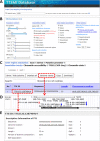The TTSMI database: a catalog of triplex target DNA sites associated with genes and regulatory elements in the human genome
- PMID: 25324314
- PMCID: PMC4384029
- DOI: 10.1093/nar/gku970
The TTSMI database: a catalog of triplex target DNA sites associated with genes and regulatory elements in the human genome
Abstract
A triplex target DNA site (TTS), a stretch of DNA that is composed of polypurines, is able to form a triple-helix (triplex) structure with triplex-forming oligonucleotides (TFOs) and is able to influence the site-specific modulation of gene expression and/or the modification of genomic DNA. The co-localization of a genomic TTS with gene regulatory signals and functional genome structures suggests that TFOs could potentially be exploited in antigene strategies for the therapy of cancers and other genetic diseases. Here, we present the TTS Mapping and Integration (TTSMI; http://ttsmi.bii.a-star.edu.sg) database, which provides a catalog of unique TTS locations in the human genome and tools for analyzing the co-localization of TTSs with genomic regulatory sequences and signals that were identified using next-generation sequencing techniques and/or predicted by computational models. TTSMI was designed as a user-friendly tool that facilitates (i) fast searching/filtering of TTSs using several search terms and criteria associated with sequence stability and specificity, (ii) interactive filtering of TTSs that co-localize with gene regulatory signals and non-B DNA structures, (iii) exploration of dynamic combinations of the biological signals of specific TTSs and (iv) visualization of a TTS simultaneously with diverse annotation tracks via the UCSC genome browser.
© The Author(s) 2014. Published by Oxford University Press on behalf of Nucleic Acids Research.
Figures


Similar articles
-
TTS mapping: integrative WEB tool for analysis of triplex formation target DNA sequences, G-quadruplets and non-protein coding regulatory DNA elements in the human genome.BMC Genomics. 2009 Dec 3;10 Suppl 3(Suppl 3):S9. doi: 10.1186/1471-2164-10-S3-S9. BMC Genomics. 2009. PMID: 19958507 Free PMC article.
-
TTSBBC: triplex target site biomarkers and barcodes in cancer.Nucleic Acids Res. 2024 Jul 5;52(W1):W547-W555. doi: 10.1093/nar/gkae312. Nucleic Acids Res. 2024. PMID: 38661214 Free PMC article.
-
Purine- and pyrimidine-triple-helix-forming oligonucleotides recognize qualitatively different target sites at the ribosomal DNA locus.RNA. 2018 Mar;24(3):371-380. doi: 10.1261/rna.063800.117. Epub 2017 Dec 8. RNA. 2018. PMID: 29222118 Free PMC article.
-
Triplex-forming oligonucleotides as modulators of gene expression.Int J Biochem Cell Biol. 2003 Jan;35(1):22-31. doi: 10.1016/s1357-2725(02)00165-6. Int J Biochem Cell Biol. 2003. PMID: 12467644 Review.
-
Triplex-forming oligonucleotides as potential tools for modulation of gene expression.Curr Med Chem Anticancer Agents. 2005 Jul;5(4):319-26. doi: 10.2174/1568011054222300. Curr Med Chem Anticancer Agents. 2005. PMID: 16101484 Review.
Cited by
-
Toward predictive R-loop computational biology: genome-scale prediction of R-loops reveals their association with complex promoter structures, G-quadruplexes and transcriptionally active enhancers.Nucleic Acids Res. 2018 Sep 6;46(15):7566-7585. doi: 10.1093/nar/gky554. Nucleic Acids Res. 2018. PMID: 29945198 Free PMC article.
-
Illuminating lncRNA Function Through Target Prediction.Methods Mol Biol. 2021;2372:263-295. doi: 10.1007/978-1-0716-1697-0_22. Methods Mol Biol. 2021. PMID: 34417758
-
Recent Advancements in Development and Therapeutic Applications of Genome-Targeting Triplex-Forming Oligonucleotides and Peptide Nucleic Acids.Pharmaceutics. 2023 Oct 23;15(10):2515. doi: 10.3390/pharmaceutics15102515. Pharmaceutics. 2023. PMID: 37896275 Free PMC article. Review.
-
Inhibition of transcription and antiproliferative effects in a cancer cell line using antigene oligonucleotides containing artificial nucleoside analogues.RSC Med Chem. 2023 May 26;14(8):1482-1491. doi: 10.1039/d3md00139c. eCollection 2023 Aug 16. RSC Med Chem. 2023. PMID: 37593572 Free PMC article.
-
Selective Preference of Parallel DNA Triplexes Is Due to the Disruption of Hoogsteen Hydrogen Bonds Caused by the Severe Nonisostericity between the G*GC and T*AT Triplets.PLoS One. 2016 Mar 24;11(3):e0152102. doi: 10.1371/journal.pone.0152102. eCollection 2016. PLoS One. 2016. PMID: 27010368 Free PMC article.
References
-
- Doan T. Le., Perrouault L., Praseuth D., Habhoub N., Decout J.L., Thuong N.T., Lhomme J., Hélène C. Sequence-specific recognition, photocrosslinking and cleavage of the DNA double helix by an oligo-[alpha]-thymidylate covalently linked to an azidoproflavine derivative. Nucleic Acids Res. 1987;15:7749–7760. - PMC - PubMed
-
- Mose H.E., Dervan P.B. Sequence-specific cleavage of double helical DNA by triple helix formation. Science. 1987;238:645–650. - PubMed
-
- Helene C. The anti-gene strategy: control of gene expression by triplex-forming-oligonucleotides. Anti-Cancer Drug Des. 1991;6:569–584. - PubMed
Publication types
MeSH terms
Substances
LinkOut - more resources
Full Text Sources
Other Literature Sources

